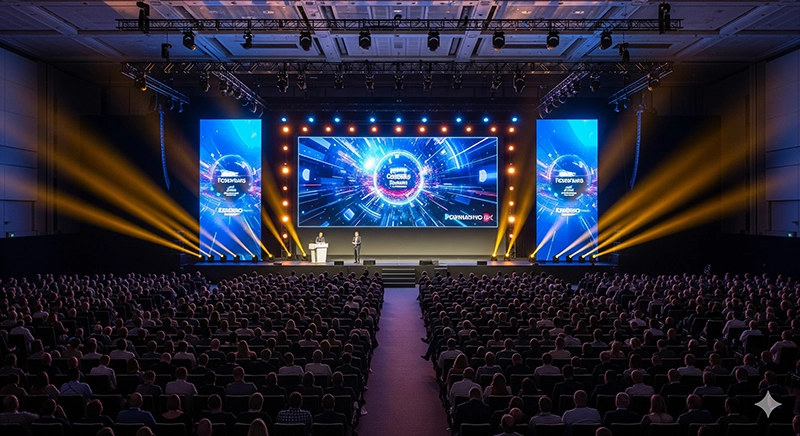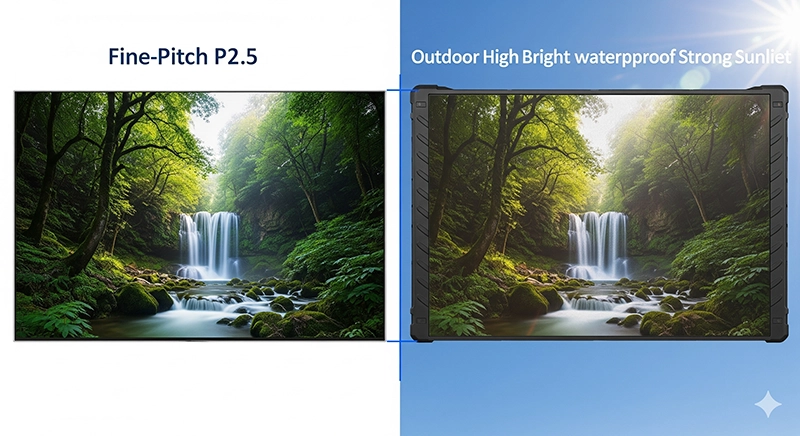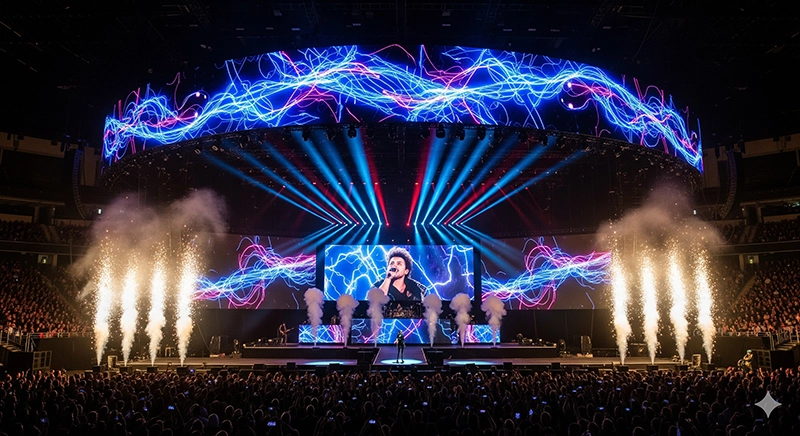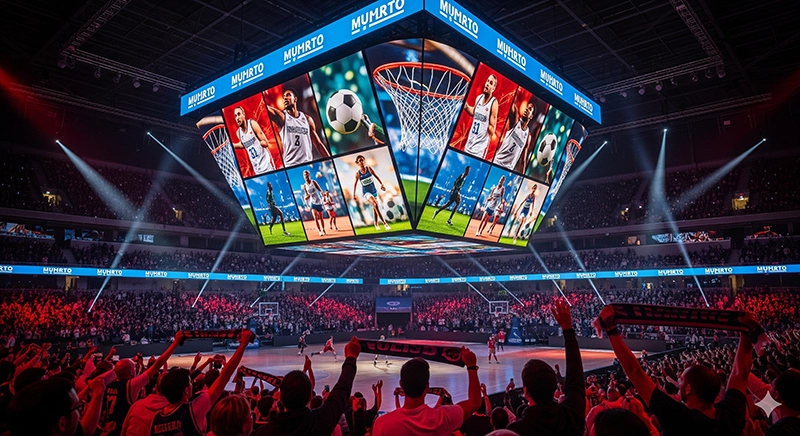Event LED screens are high-definition digital displays that have become essential for concerts, conferences, exhibitions, and corporate events. They are usually available for short-term or long-term rental, with pricing influenced by screen size, resolution, duration, and service level. More importantly, their real value lies in delivering strong visual impact that enhances audience engagement, brand identity, and overall event experience.
An event LED screen is a modular display system designed to project dynamic content at a large scale. Unlike LCD panels or traditional projection systems, LED screens are built from light-emitting diodes that provide superior brightness, wide viewing angles, and seamless image quality even in challenging lighting conditions. Their modular design allows them to be scaled up or down to match different event venues, ranging from small conferences to massive stadium concerts.
Applications include product launches, live concerts, exhibitions, trade shows, sports events, and even outdoor festivals. Because of their adaptability, event LED screens are now a preferred choice for organizations that want to create immersive experiences and ensure that every attendee, regardless of seating, can clearly see the content on display.
Designed for one-time concerts, corporate meetings, or weddings.
Provides flexibility and lower upfront costs compared to purchasing equipment.
Suppliers usually offer setup, calibration, and dismantling services included.
Ideal for touring shows, sports leagues, or recurring exhibitions.
Suppliers may offer reduced rates for longer contracts, making this cost-effective.
Ensures consistency across multiple venues with the same visual setup.
Comprehensive rental solution including screens, truss systems, control software, and technicians.
Preferred by companies and agencies that do not want to manage the technical complexity.
Often comes with real-time monitoring and backup systems for risk management.
Pixel pitch (the distance between LEDs) directly impacts resolution and cost. Smaller pitches (P2.5 or below) provide sharper images but are more expensive.
Larger stage setups require more panels, increasing both equipment and labor costs.
Outdoor LED screens need weatherproofing, higher brightness (5,000+ nits), and durable casing.
Indoor models prioritize fine pixel pitch for close viewing but cost less in logistics.
Rates vary from daily rentals to monthly contracts, with significant discounts for extended periods.
Transport, installation, and dismantling are often billed separately, depending on venue accessibility.
Most suppliers charge additional fees for on-site engineers and technicians.
Premium service packages may include 24/7 monitoring, spare modules, and immediate replacements.
Curved or 3D LED screen setups create immersive environments that captivate audiences.
Synchronization with lighting and pyrotechnics increases the dramatic effect.
High-quality visual content, including motion graphics and branded visuals, elevates the professional look.
Interactive elements such as real-time audience voting or social media walls boost engagement.
Large LED screens make every attendee feel closer to the action, regardless of seating position.
Compared to projectors, LED screens deliver consistent brightness and visibility even in daylight.
Organizations often struggle with the decision to rent or purchase LED screens. Renting minimizes upfront investment and suits companies hosting occasional events. Purchasing, however, is ideal for production companies or venues that require frequent use. Below is a comparison:
| Aspect | Rental | Purchase |
|---|---|---|
| Initial Cost | Low | High |
| Flexibility | High | Limited once purchased |
| Maintenance | Supplier responsibility | Buyer responsibility |
| Suitability | Occasional events | Frequent or permanent installations |
Evaluate product quality, certifications, and portfolio of past projects.
Check supplier capacity to deliver, install, and support within required timelines.
Do you provide on-site technical support during events?
What are the options for customized screen sizes and formats?
Is content management software included in the rental package?
Work with suppliers who have global event experience and reliable logistics networks.
Partnerships with trusted rental firms ensure consistent quality across venues.
The event LED screen industry is evolving rapidly. Virtual production LED walls are expanding from film studios into live events, offering real-time immersive backgrounds. Transparent LED screens are entering retail and event spaces to combine physical and digital experiences. Sustainability is also a growing priority, with suppliers introducing energy-efficient panels and recyclable modules.
For event organizers and corporate buyers, keeping pace with these innovations ensures not only cost efficiency but also the ability to deliver memorable, future-ready experiences.
Event LED screens are high-definition digital displays that have become essential for concerts, conferences, exhibitions, and corporate events. They are usually available for short-term or long-term rental, with pricing influenced by screen size, resolution, duration, and service level. More importantly, their real value lies in delivering strong visual impact that enhances audience engagement, brand identity, and overall event experience.
An event LED screen is a modular display system designed to project dynamic content at a large scale. Unlike LCD panels or traditional projection systems, LED screens are built from light-emitting diodes that provide superior brightness, wide viewing angles, and seamless image quality even in challenging lighting conditions. Their modular design allows them to be scaled up or down to match different event venues, ranging from small conferences to massive stadium concerts.
Applications include product launches, live concerts, exhibitions, trade shows, sports events, and even outdoor festivals. Because of their adaptability, event LED screens are now a preferred choice for organizations that want to create immersive experiences and ensure that every attendee, regardless of seating, can clearly see the content on display.
Designed for one-time concerts, corporate meetings, or weddings.
Provides flexibility and lower upfront costs compared to purchasing equipment.
Suppliers usually offer setup, calibration, and dismantling services included.
Ideal for touring shows, sports leagues, or recurring exhibitions.
Suppliers may offer reduced rates for longer contracts, making this cost-effective.
Ensures consistency across multiple venues with the same visual setup.
Comprehensive rental solution including screens, truss systems, control software, and technicians.
Preferred by companies and agencies that do not want to manage the technical complexity.
Often comes with real-time monitoring and backup systems for risk management.
Pixel pitch (the distance between LEDs) directly impacts resolution and cost. Smaller pitches (P2.5 or below) provide sharper images but are more expensive.
Larger stage setups require more panels, increasing both equipment and labor costs.
Outdoor LED screens need weatherproofing, higher brightness (5,000+ nits), and durable casing.
Indoor models prioritize fine pixel pitch for close viewing but cost less in logistics.
Rates vary from daily rentals to monthly contracts, with significant discounts for extended periods.
Transport, installation, and dismantling are often billed separately, depending on venue accessibility.
Most suppliers charge additional fees for on-site engineers and technicians.
Premium service packages may include 24/7 monitoring, spare modules, and immediate replacements.
Curved or 3D LED screen setups create immersive environments that captivate audiences.
Synchronization with lighting and pyrotechnics increases the dramatic effect.
High-quality visual content, including motion graphics and branded visuals, elevates the professional look.
Interactive elements such as real-time audience voting or social media walls boost engagement.
Large LED screens make every attendee feel closer to the action, regardless of seating position.
Compared to projectors, LED screens deliver consistent brightness and visibility even in daylight.
Organizations often struggle with the decision to rent or purchase LED screens. Renting minimizes upfront investment and suits companies hosting occasional events. Purchasing, however, is ideal for production companies or venues that require frequent use. Below is a comparison:
| Aspect | Rental | Purchase |
|---|---|---|
| Initial Cost | Low | High |
| Flexibility | High | Limited once purchased |
| Maintenance | Supplier responsibility | Buyer responsibility |
| Suitability | Occasional events | Frequent or permanent installations |
Evaluate product quality, certifications, and portfolio of past projects.
Check supplier capacity to deliver, install, and support within required timelines.
Do you provide on-site technical support during events?
What are the options for customized screen sizes and formats?
Is content management software included in the rental package?
Work with suppliers who have global event experience and reliable logistics networks.
Partnerships with trusted rental firms ensure consistent quality across venues.
The cost of event LED screens has evolved significantly over the past decade. In earlier years, high-resolution LED panels were considered luxury equipment, with pixel pitches below P5 commanding premium rates. Today, thanks to advancements in LED chip production and large-scale manufacturing in Asia, prices have dropped by 30–50% compared to five years ago. This decline has made LED screen rental more accessible to mid-sized events and corporate clients that previously relied on projection systems.
Looking ahead, three major factors will influence pricing trends:
Mini and Micro LED technology: As production matures, these finer-pitch panels will enter mainstream event rentals, offering sharper visuals at competitive rates.
Supply chain stability: Geopolitical shifts and raw material availability will impact the cost of LED chips and driver ICs, directly affecting rental pricing.
Sustainability initiatives: Panels designed with lower power consumption and recyclable materials may initially cost more, but long-term savings on energy bills will drive adoption.
Behind every event LED screen is a complex global supply chain. Panels are typically assembled in specialized factories, with different components sourced from various regions:
LED chips: Primarily produced in China, Taiwan, and South Korea, chip quality determines brightness and lifespan.
Driver ICs: Manufactured in Taiwan and Japan, these components ensure precise image rendering and refresh rates.
Cabinets and frames: Built for durability, lightweight aluminum or magnesium alloys are used to simplify transport and installation.
Control systems: Software and hardware for managing content playback, sourced from companies specializing in event technologies.
For buyers and event organizers, understanding the supply chain is crucial. It allows procurement teams to evaluate potential risks, such as delivery delays or component shortages, which may impact event timelines.
Music festivals rely heavily on LED screens to project live footage and dynamic visuals. For example, a 60,000-seat stadium concert may use multiple 200-square-meter LED walls, combined with side screens for remote audience visibility. Rental costs in such cases can exceed $250,000 per event, covering transport, setup, technicians, and dismantling.
For international trade shows, event LED screens often serve as interactive digital backdrops. Exhibitors integrate product videos, live presentations, and branded content. In these contexts, rental packages range between $10,000–$50,000 depending on size and customization.
Temporary LED screens are increasingly used in sports tournaments for live replay, sponsor branding, and fan engagement. Their modularity allows for quick setup and dismantling, supporting multi-location leagues and seasonal competitions.
Choosing between international and local LED screen suppliers depends on priorities such as cost, reliability, and customization.
| Aspect | International Supplier | Local Supplier |
|---|---|---|
| Cost | Higher due to logistics | Lower, reduced shipping costs |
| Customization | Advanced options, cutting-edge panels | Standard sizes, limited customization |
| Support | Comprehensive, multilingual teams | Quick response, local technicians |
| Lead Time | Longer (import process) | Shorter, ready inventory |
For global brands hosting high-profile events, international suppliers may be preferred for guaranteed quality. However, for regional exhibitions or weddings, local suppliers offer faster turnaround and competitive pricing.
Procurement managers should use a structured approach when sourcing event LED screens. Below is a checklist that can be adapted for RFPs (Request for Proposals):
Define screen size, resolution, and pixel pitch requirements.
Specify indoor or outdoor usage conditions (IP rating, brightness).
Confirm rental duration, including setup and dismantling time.
Request details on technical support and emergency backup solutions.
Evaluate energy consumption and sustainability features.
Ask for previous project references and certifications.
A well-prepared RFP not only ensures accurate supplier quotes but also helps avoid unexpected costs and logistical challenges during the event.
The next five years will see significant transformation in event LED screen usage. Integration with augmented reality (AR) and virtual production systems will blur the line between physical and digital environments. Transparent LED panels will allow event designers to combine physical stage elements with dynamic content overlays. Additionally, advances in energy efficiency will align with global sustainability goals, making LED screens more eco-friendly and cost-effective.
For B2B buyers, staying ahead of these trends will be critical. Early adopters of innovative LED technologies will not only deliver memorable experiences but also differentiate themselves in competitive markets such as entertainment, sports, and exhibitions.
Hot Recommendations
Hot Products
Get a Free Quote Instantly!
Talk to Our Sales Team Now.
If you are interested in our products, please contact us promptly
Reach out to our sales team to explore customized solutions that perfectly meet your business needs and address any questions you may have.
Email Address:info@reissopto.comFactory Address:Building 6, Huike Flat Panel Display Industrial Park, No. 1, Gongye 2nd Road, Shiyan Shilong Community, Bao'an District, Shenzhen city , China
whatsapp:+8615217757270